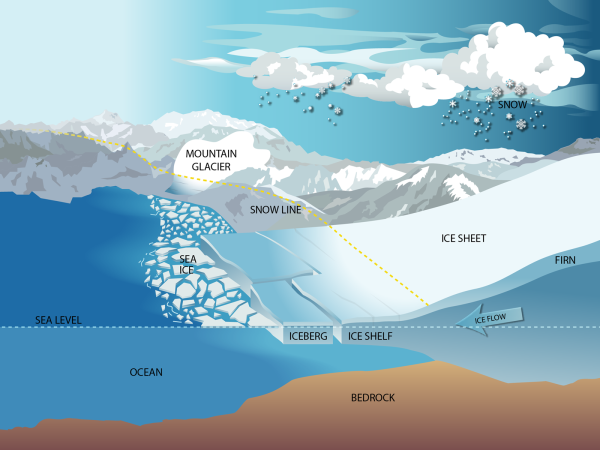RAPID ICE MELTING
1. Context
The rapid melting of West Antarctica’s ice sheet due to warm waters around it is now unavoidable, no matter how much carbon emissions are cut, according to a new study.
2. What is an ice Sheet?
- An ice sheet can be described as a vast expanse of glacial ice that extends over an area exceeding 50,000 square kilometers, which is approximately equivalent to covering the state of Uttarakhand with ice.
- Currently, the world hosts two significant ice sheets: the Greenland ice sheet and the Antarctica ice sheet. These two ice sheets collectively hold roughly two-thirds of the Earth's freshwater resources.
- As indicated in a NASA report, the implication of this is that as ice sheets accumulate mass over time, they play a role in reducing the global average sea level. Conversely, when ice sheets lose mass, they contribute to an increase in the global average sea level

3. How is the West Antarctica ice melting?
- There are several mechanisms involved in the melting of ice sheets, and one of these processes occurs when warm ocean waters cause the ice shelves at the edges of the ice sheet, which float on the ocean, to melt.
- These ice shelves play a crucial role in stabilizing the glaciers located on the land behind them. When an ice shelf thins or vanishes, the glaciers tend to accelerate, releasing more ice into the ocean and leading to a rise in sea levels.
- It's important to note that both ice shelves and ice sheets are distinct from sea ice, which consists of freely floating ice found in the polar regions and forms through the freezing of seawater.
- This same phenomenon is occurring in West Antarctica, specifically in the Amundsen Sea, which is the primary focus of Naughten's research.
- Over the decades, the ice shelves in this region have been diminishing, glaciers have been moving more rapidly toward the ocean, and the ice sheet has been diminishing.
4. Findings of the Study
- To perform this analysis, scientists have employed a high-resolution computer model specifically designed for the Amundsen Sea, allowing for the most comprehensive evaluation of West Antarctica's warming to date.
- This model has been utilized to conduct numerous simulations spanning the 21st century, encompassing a cumulative period of more than 4,000 years of ocean warming and ice-shelf melting in the Amundsen Sea.
- These simulations have considered various scenarios related to fossil fuel consumption, ranging from an optimistic best-case scenario aligned with the goals of the Paris Agreement, limiting global warming to 1.5°C, to a worst-case scenario involving uncontrolled utilization of coal, oil, and gas. Additionally, they have factored in the influence of natural climate variations, such as the timing of events like El Niño.
- In all these scenarios, a notable and widespread increase in future warming of the Amundsen Sea and heightened ice shelf melting is evident. Furthermore, there is little distinction among the scenarios until the year 2045.
- Notably, when examining the 1.5°C scenario, statistically, it parallels a mid-range scenario, which closely resembles the expected outcomes of current commitments to reduce fossil fuel usage over the forthcoming decades.
- These developments are anticipated to lead to a rise in sea levels, with global implications for coastal communities, including those in India.
- India, owing to its extensive coastline and high population density, is particularly susceptible to sea level rise. If these coastal communities cannot afford protective measures like constructing sea wa
5. Way forward
Although the findings are bleak, they shouldn’t discourage the efforts to mitigate the impacts of climate change, the study highlights. According to the researchers, the melting West Antarctic ice sheet is just one contributor to sea level rise, which is just one impact of climate change.
|
Previous Year Questions
1.La Nina is suspected to have caused recent floods in Australia. How is La Nina different from El Nino? (UPSC CSE 2011)
1. La Nina is characterized by unusually cold ocean temperature in the equatorial Indian Ocean whereas El Nino is characterized by unusually warm ocean temperature in the equatorial Pacific Ocean.
2. El Nino has an adverse effect on the south-west monsoon of India, but La Nina has no effect on the monsoon climate.
Which of the statements given above is/are correct?
A. 1 Only
B. 2 Only
C. Both 1 and 2
D. Neither 1 nor 2
Answer (D)
|
Source: indianexpress




